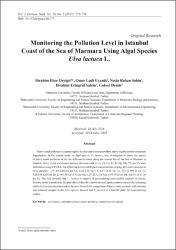Monitoring the Pollution Level in Istanbul Coast of the Sea of Marmara Using Algal Species Ulva lactuca L.

Göster/
Erişim
info:eu-repo/semantics/openAccessTarih
2017Yazar
Özyiğit, İbrahim İlkerUYanık, Ömer Lutfi
Şahin, Necla Ruken
Yalçın, İbrahim Etuğrul
Demir, Göksel
Üst veri
Tüm öğe kaydını gösterÖzet
Heavy metal pollution in coastal regions has become a serious problem due to significant environmental degradations. In the present study, an algal species, U. lactuca, was investigated to assess the impact of heavy metal pollution on the six different locations along the coastal line of the Sea of Marmara in Istanbul. Heavy metal and mineral nutrient elements such as Ca, Cd, Cu, Fe, K, Mg, Mn, Pb, and Zn were determined using ICP-OES. The following lowest and highest concentrations (mg/kg; dw) were measured in Ulva samples: 1,751.66-2,465.68 for Ca, 0.45-3.22 for Cd, 6.67-18.32 for Cu, 553.32-989.33 for Fe, 3,264.48-4,301.68 for K, 961.50-1,614.53 for Mg, 8.27-25.32 for Mn, 4.93-19.32 for Pb, and 15.16-41.30 for Zn. The data revealed that U lactuca is capable of accumulating considerable amounts of metals. Besides, metal deposition in the plant did not alter the mineral nutrient uptake pattern extensively, indicating relatively less contamination risk in the area. Overall, the comparison of heavy metal contents with seawater and sediment samples in the Ulva species showed that U lactuca is a suitable plant for biomonitoring studies.


















